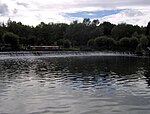Saltford railway station
Disused railway stations in SomersetFormer Great Western Railway stationsGreat Western Main LinePages with no open date in Infobox stationProposed railway stations in England ... and 3 more
Railway stations in Great Britain closed in 1970Railway stations in Great Britain opened in 1840Use British English from December 2017

Saltford railway station was a small station on the Great Western Main Line between Bath and Bristol in use between 1840 and 1970. It served the village of Saltford, Somerset. A local group is campaigning to have the station reopened.
Excerpt from the Wikipedia article Saltford railway station (License: CC BY-SA 3.0, Authors, Images).Saltford railway station
The Shallows, Bristol
Geographical coordinates (GPS) Address Website Nearby Places Show on map
Geographical coordinates (GPS)
| Latitude | Longitude |
|---|---|
| N 51.3997 ° | E -2.4501 ° |
Address
The Riverside Inn
The Shallows
BS31 3EZ Bristol
England, United Kingdom
Open on Google Maps








